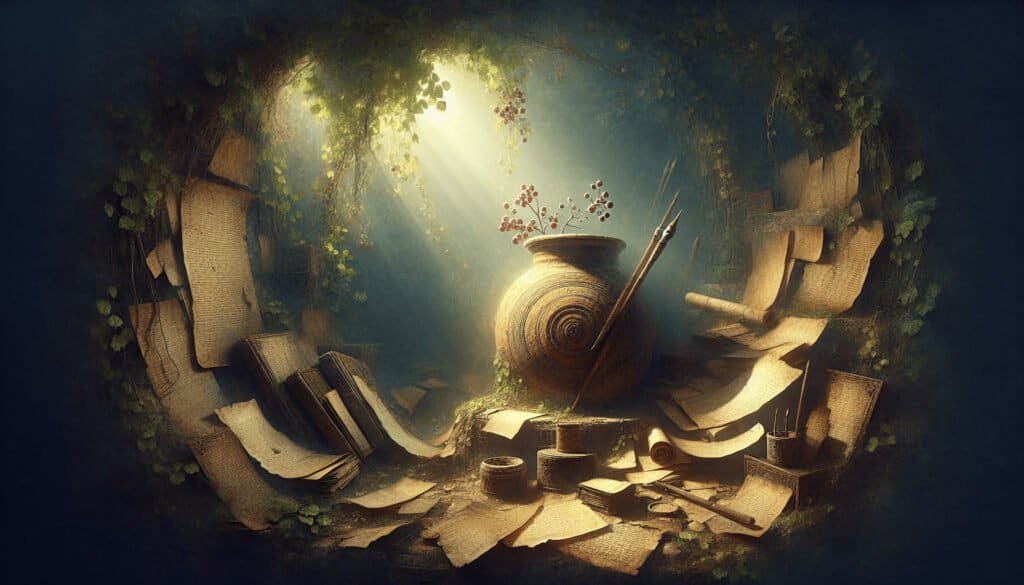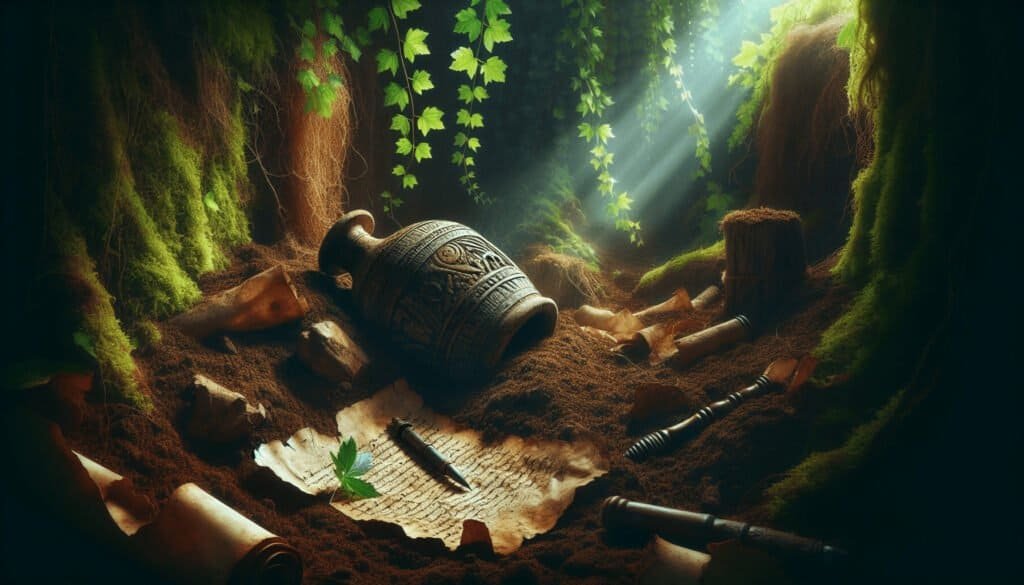What do you think when you hear the phrase “buried wine jar,” especially when tied with ancient scribes and their quest for unbiased documentation? It conjures up images of meticulous scribes, immersed in scripts and scrolls while adhering to a weighty tradition. So, let’s unravel the threads of this fascinating concept while engaging with the rich tapestry of biblical archaeology and historical manuscripts.

The Enigma of the Buried Wine Jar
Ancient wine jars have been turning heads in archaeological digs, and for good reason. They’re not just ordinary objects; they hold incredible stories about cultures, rituals, and the people who lived long before us. Imagine a jar, buried long ago, now unearthed, telling tales that historians could only dream about.
A Look at the Historical Context
Picture this: you’re in the ancient Near East, thousands of years ago. Wine wasn’t just a beverage; it was a symbol of celebration, divinity, and social status. It played crucial roles in religious ceremonies and community gatherings. The wine jar, often beautifully crafted, was as much about practicality as it was a marker of social significance.
The jars themselves were made from clay, with some reaching impressive heights; these were no mere kitchenware. They were functional art pieces, utilized for storing and transporting wine. When scribes referred to them in ancient texts, they weren’t just documenting mundane details—they were also embedding cultural narratives within those references.
The Role of Scribes in Ancient Civilizations
It’s hard not to admire the scribes of ancient times. They weren’t merely copyists but custodians of knowledge and culture. Many civilizations, including the Egyptians, Mesopotamians, and later the Israelites, relied heavily on these skilled individuals to ensure that their histories, laws, and stories were preserved for generations.
The Codification of Texts
Have you ever considered what it meant to be a scribe back then? Picture sitting in a bustling scriptorium, the scent of ink and papyrus filling the room. Scribes dedicated their lives to the painstaking task of copying texts with minimal errors. They were trained to follow strict guidelines.
The concept of copying without bias was central to their work. This wasn’t merely a suggestion; it was a commandment of sorts. The belief was that altering or embellishing texts could lead to misrepresentation of people or events, which could have significant implications for society.
- Preservation of Knowledge: By copying texts accurately, scribes ensured that future generations would have access to their historical and cultural legacies.
- Religious Texts: Scribes held significant roles in sacred spaces, copying religious texts that were intrinsic to community identity and belief systems.
Isn’t it fascinating how vital their role was in shaping narratives?
The Divine Command: “Copy Without Bias”
Ancient scribes faced immense pressure to maintain accuracy. The phrase “copy without bias” becomes an intriguing focal point here. You see, they believed that the truths of their society were intertwined with divine will. Any personal or political bias on their part could distort important narratives, fundamentally altering the course of history.
Sacred Duties and Responsibilities
Being a scribe wasn’t just an occupation; it was a sacred duty. Think about the heavy load of responsibility those individuals must have felt. Each character they etched onto papyrus or stone carried significant weight.
- Impact of Religion: The scribes often worked within religious institutions, where accuracy was paramount. They believed their work was divinely inspired, leading them to adhere strictly to existing texts.
- Legal Documents: In addition to sacred texts, scribes also recorded legal documents. A biased depiction could alter the interpretation of laws and testimonies, impacting lives and societal structures.
This brings us to the heart of how they approached their craft: with respect for the text, and an overwhelming sense of duty to their community.
Archeological Insights: Finding the Archives of the Ancients
With recent archaeological findings, the world has gained more profound insights into ancient scribal practices. Not only do these findings provoke fascination, but they also illustrate how significant this work truly was.
The Discovery of Ancient Scrolls
Among the most notable discoveries are the Dead Sea Scrolls, which contain biblical texts that date back thousands of years. This cache of scrolls offers a glimpse into the lives of scribes tasked with preserving sacred texts. Scientists and archaeologists alike have analyzed these scrolls, revealing a wealth of information about scribing practices.
- Textual Variants: The presence of different variants on common texts raises questions about how scribes interpreted and copied their sources. Were they adhering strictly to the original, or were they making minor adjustments?
- Cultural Significance: The preservation of these texts is a testimony to the devotion of scribes and the societies in which they participated. Their dedication ensured that their beliefs and histories were safeguarded over generations.
Imagine the thrill of uncovering a scroll that has been buried for centuries. It’s like holding a piece of the past in your hands, a direct link to the voices of individuals long gone.

The Cultural Ramifications of Scribing Without Bias
What does it mean when we say ancient scribes copied texts without bias? It reflects a culture valuing authenticity and historical accuracy.
The Influence on Modern Textual Criticism
Fast-forward to today, and this lineage of meticulous record-keeping plays a critical role in modern textual criticism. Scholars examine ancient documents with a fine-toothed comb, analyzing discrepancies and aiming to reconstruct original texts.
- Textual Integrity: Much of what we understand about the transmission of ancient texts hinges on the work of these scribes. The commitment to copy without bias has laid the foundation for contemporary approaches to historical documentation.
- Cultural Identity: For modern communities, especially among those who adhere to religions rooted in ancient texts, the dedication of these scribes continues to carry significant weight, reinforcing cultural identities.
When you think about it, you’re standing on the shoulders of those scribes, confronting enduring questions of authenticity and representation.
Connecting Ancient Customs to Contemporary Practices
If you’ve ever pondered the relevance of ancient practices in your daily life, the connection between biblical narratives and modern literature becomes quite apparent. The commitment to truth in recording history resonates deeply, influencing how you read and interpret texts today.
Ethical Considerations of Documentation
In the digital age, the idea of recording without bias takes on new dimensions.
- Journalism and Media: The principles adhered to by ancient scribes inform contemporary journalism. Striking a balance between objectivity and personal narrative is a challenge you can recognize today.
- History and Memory: In communities, history continues to shape personal and collective identities. The emphasis on factual recounting can affect how societies view their past, influencing culture and public discourse.
Think about the implications of this! The ancient past and today’s world intersect, revealing timeless challenges about how we depict truth.
Lessons to Be Learned from Scribes
Can you see the legacy that scribes left behind? It’s as though their commitment to their art has informed generations. As you reflect on this, several lessons emerge that can resonate deeply in your life.
The Importance of Accuracy in Storytelling
- Respect the Source: Much like ancient scribes, valuing the source material is crucial in ensuring the integrity of your narrative.
- Seek Objectivity: It’s easy to inject personal perspectives, but learning to set that aside will enhance the authenticity of your work.
- Preservation of Culture: Just as scribes served to protect their culture, you too can contribute by documenting stories that might otherwise fade into obscurity.
What a noble craft, right?
Conclusion: Bridging Ancient Wisdom and Modern Understanding
As you wrap your mind around the profound implications of ancient scribes and their steadfast commitment to honesty, it’s essential to recognize that their methods shaped more than texts; they fundamentally influenced the very fabric of societal memory.
- Cognitive Histories: Today, we bear witness to generations of wisdom passed down through written words, underscoring the responsibility placed on you to write honestly and justly.
- A Shared Legacy: The connection you hold with those scribes isn’t merely an academic pursuit; it’s a shared legacy, extending the notion of storytelling as a binding force across time and space.
So, the next time you hear the term “buried wine jar” or encounter ancient texts, you’ll have an enriched perspective, recognizing the intricate network of historical documentation, the culture of preservation, and the vital role of scribes in maintaining the truths of human experience.
Understanding this rich interplay between antiquity and the present can inspire you to reflect on the narratives you construct and the roles you play in shaping history, however small they might seem. Embrace that responsibility—after all, you might just be the modern scribe whose words will echo through time.


